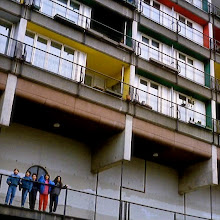Der um eingängige Prägungen nicht verlegene Guardian
labelt Alessandro Micheles erste Gucci-Show als „librarian
chic“. Die NYT titelt: „At Gucci, a New Philosophy“ und
erklärt dankenswerterweise auch, um welche Philosophie
es sich handelt: „And on each seat: a sheet of paper that
mused on time and disconnection, framed by two quotes —
one from the Italian philosopher Giorgio Agamben and one
from the French philosopher Roland Barthes — and titled
after the latter: ‘The Contemporary is the Untimely’.“
Was auf dem Blatt Papier stand, das auf allen Stühlen lag,
entnehme ich der
niederländischen Vogue. Allen fashionlabelt Alessandro Micheles erste Gucci-Show als „librarian
chic“. Die NYT titelt: „At Gucci, a New Philosophy“ und
erklärt dankenswerterweise auch, um welche Philosophie
es sich handelt: „And on each seat: a sheet of paper that
mused on time and disconnection, framed by two quotes —
one from the Italian philosopher Giorgio Agamben and one
from the French philosopher Roland Barthes — and titled
after the latter: ‘The Contemporary is the Untimely’.“
Was auf dem Blatt Papier stand, das auf allen Stühlen lag,
victims, die sich mit dem Positionspapier Micheles kritisch
auseinandersetzen möchten, sei die Lektüre von Agambens
Essay „Was ist Zeitgenossenschaft?“ (Nacktheiten, FfM 2010,
21-35) empfohlen. (Bleibt zu erwähnen, dass Agamben näch-
sten Mittwoch auf der 39. Generalversammlung der italieni-
schen Franziskaner [Frati Minori, Conventuali, Cappuccini
und Terz'Ordine Regolare] einen Vortrag hält: „Francesco
qui e ora“. Mangelnde „Anschlussfähigkeit“ kann man ihm
jedenfalls nicht vorwerfen.)
‘Those who are truly contemporary are those who nei-
ther perfectly coincide with their time nor adapt to its
demands. In this sense, they are never at home in the
present moment. But precisely through this disconnection
and this anachronism, they are more capable than others
of perceiving and grasping their own time. Contemporari-
ness, then, is that relationship with time that adheres to
it through a disconnection.’ (G. Agamben)
The Autumn/Winter collection for 2015-16 explores the
world through this disconnection. It doesn’t limit itself to
a simple recording of the present, rather it embodies that
elusive threshold between the ‘no longer’ and the ‘not yet.’
This is a threshold of temporal fluxes, where relics of the
past merge with signs of the future. Within this frame, for-
gotten fragments become incorporated into new horizons
of meaning: flowers borrowed from tapestries abandoned
in old attics, birds embroidering precious promises of love
inspired by Georgian atmospheres, pleated dresses whose
folds overflow with memories. The collection celebrates
untimely details, quintessential interferences, discrepancies
and diachronies, which reclaim their discordance with the
present in order to better comprehend the present itself.
There is no room for consolatory nostalgia. Rather the need
to affirm freedom. The freedom to revive stored-up possibi-
lities. The freedom to construct new meanings at the inter-
section of diverging temporalities. The freedom to choose
who you are, beyond what has already been dictated.
The contemporary city as background: a place of unexpec-
ted events, rifts, remnants and amnesias. But above all it is
a place for the mingling of reality and desire, testimonies
and prophecies, traces of pre-existing worlds and glimmers
of worlds in the making: the clues required to create new
languages and to envisage new possibilities of existence.
‘The contemporary is the untimely’ (R. Barthes)
GUCCI


